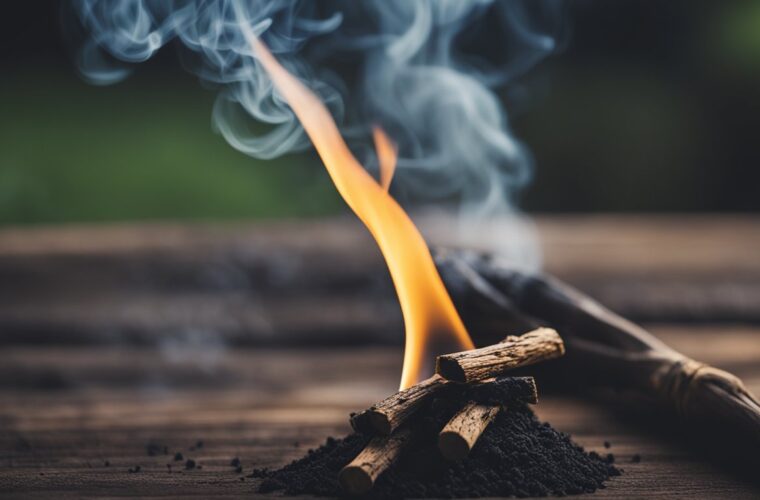If you’re someone who burns Palo Santo, you may have noticed that the smoke can sometimes be a different color than usual. Specifically, you may have seen black smoke, which can be concerning since it’s not the typical white smoke that most people associate with the wood. However, before you panic, it’s important to understand that black smoke from burning Palo Santo is not necessarily a bad thing.

In fact, according to some sources, black smoke can actually be a sign that the wood is doing its job. When burned, Palo Santo is said to release negative energy and purify the air around you. Black smoke can indicate that the wood is absorbing this negative energy and carrying it away, leaving you with a cleaner and more positive environment. However, it’s important to note that this interpretation is based on personal beliefs and experiences, and there is no scientific evidence to support it.
That being said, it’s also possible that black smoke from burning Palo Santo could be a sign that the wood is not of good quality or has not been stored properly. In this case, the black smoke could be due to the presence of chemicals or other impurities in the wood. If you’re concerned about the quality of your Palo Santo or the smoke it’s producing, it’s always a good idea to purchase from a reputable source and store it in a cool, dry place.
Understanding Palo Santo
Palo Santo is a mystical tree that grows in South America. The tree is known for its fragrant wood, which is used for various purposes, including making incense and smoking blends. When burned, the Palo Santo wood produces a sweet, fragrant smoke that is believed to have healing properties.
Origins of Palo Santo
The Palo Santo tree is native to the Yucatan Peninsula, Central America, and South America. The tree grows in dry tropical forests and can reach up to 30 feet in height. The wood of the Palo Santo tree is harvested after the tree has died naturally, and it must be left to dry for at least four years before it can be used.
Cultural Significance
The use of Palo Santo has a long history in South American culture. The indigenous people of the Andes have used Palo Santo for centuries in their spiritual and medicinal practices. The smoke from burning Palo Santo is believed to have cleansing and healing properties, and it is often used in shamanic rituals to clear negative energy and promote positive energy.
In addition to its spiritual and medicinal uses, Palo Santo is also used in aromatherapy and as a natural insect repellent. The wood contains high levels of limonene, a natural compound that gives it its distinctive scent and is also found in citrus fruits.
Overall, Palo Santo is a fascinating and versatile tree that has played an important role in South American culture for centuries. Whether you use it for spiritual purposes, as an insect repellent, or simply to enjoy its fragrant aroma, Palo Santo is a unique and valuable resource.
Interpreting Black Smoke
When burning palo santo, the color of the smoke can vary depending on several factors, including the rate at which it is burned and the oils present in the wood. One of the colors you may see is black smoke. While black smoke is often associated with negative connotations, when burning palo santo, it can indicate the presence of negative or stagnant energy being cleared away.
Common Causes
There are several reasons why palo santo may produce black smoke. One common cause is that the wood has not been properly cured or dried. When the wood is not fully cured, it may contain excess moisture, which can cause the smoke to be darker and thicker.
Another cause of black smoke can be the rate at which the palo santo is burned. If the wood is burned too quickly, it may produce more smoke, which can be darker in color. It is important to burn palo santo at a slow and steady pace to prevent this from happening.
Spiritual Perspectives
From a spiritual perspective, black smoke during a palo santo burning ceremony can indicate that negative energy is being released and cleared away. This can be seen as a positive sign, as it shows that the palo santo is doing its job of clearing the space and promoting positive energy.
Some people believe that the black smoke represents the release of negative emotions or energy that has been trapped within the space. Others believe that the black smoke is a sign that the palo santo is working to purify the air and cleanse the environment.
Regardless of the interpretation, black smoke during a palo santo burning ceremony should not be a cause for alarm. It is a natural occurrence that can be seen as a sign that the palo santo is doing its job of promoting positive energy and clearing away negative energy.
Practical Tips for Burning Palo Santo
Proper Usage
When burning Palo Santo, it is important to use it properly to ensure a safe and effective experience. To begin, hold the stick at a 45-degree angle and light the tip with a lighter or match. Allow the stick to burn for 30 seconds to one minute before blowing out the flame. This will create a smoldering ember that will release the fragrant smoke.
It is recommended to use a fireproof bowl or dish to catch any falling ash or embers. This will prevent any potential fire hazards and keep your space clean. You can also hold the Palo Santo over the bowl to catch any ash that falls.
Avoiding Black Smoke
If you notice black smoke when burning Palo Santo, don’t worry, this is a normal occurrence. When the wood is first lit, the smoke is typically black. However, if you continue to see black smoke, it may indicate that the Palo Santo is not being burned properly.
To avoid black smoke, make sure to hold the stick at a 45-degree angle and allow the flame to die down before blowing it out. This will create a smoldering ember that will release the fragrant smoke. You can also try using a smaller piece of Palo Santo or breaking it into smaller pieces to help it burn more evenly.
By following these proper usage tips and avoiding black smoke, you can enjoy the benefits of Palo Santo burning without any safety concerns or negative effects.




